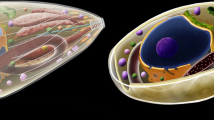Abstract
Plasmodium falciparum malaria affects about 500 million people worldwide and is responsible for approximately 2.5 million deaths per year. Glycosylphosphatidylinositol (GPI) is the major anchor for membrane-associated proteins of P. falciparum and GPI plays a major role as a toxin in the pathology of malaria. Therefore, we tested the hypothesis that GPI, like LPS, induces apoptosis in vitro and in vital organs of mice. Our data does not provide evidence for direct cardiomyocyte apoptosis induced by GPI in vitro. However, in vivo injection of GPI induced limited apoptosis in mouse liver and spleen tissue. Apoptosis may be due to a direct GPI apoptotic effect or to an indirect effect via the induction of TNFα and nitric oxide production.


Similar content being viewed by others
References
Helmby H, Jonsson G, Troye-Blomberg M (2000) Cellular changes and apoptosis in the spleens and peripheral blood of mice infected with blood-stage Plasmodium chabaudi chabaudi AS. Infect Immun 68(3):1485–1490
Guha M, Kumar S, Choubey V, Maity P, Bandyopadhyay U (2006) Apoptosis in liver during malaria: role of oxidative stress and implication of mitochondrial pathway. Faseb J 20(8):1224–1226
Potter SM, Chan-Ling T, Rosinova E, Ball HJ, Mitchell AJ, Hunt NH (2006) A role for Fas-Fas ligand interactions during the late-stage neuropathological processes of experimental cerebral malaria. J Neuroimmunol 173(1–2):96–107
Riccio EK, Junior IN, Riccio LR et al (2003) Malaria associated apoptosis is not significantly correlated with either parasitemia or the number of previous malaria attacks. Parasitol Res 90(1):9–18
Balde AT, Sarthou JL, Roussilhon C (1995) Acute Plasmodium falciparum infection is associated with increased percentages of apoptotic cells. Immunol Lett 46(1–2):59–62
Pino P, Vouldoukis I, Kolb JP et al (2003) Plasmodium falciparum–infected erythrocyte adhesion induces caspase activation and apoptosis in human endothelial cells. J Infect Dis 187(8):1283–1290
McConville MJ, Ferguson MA (1993) The structure, biosynthesis and function of glycosylated phosphatidylinositols in the parasitic protozoa and higher eukaryotes. Biochem J 294(Pt 2):305–324
Tachado SD, Gerold P, McConville MJ et al (1996) Glycosylphosphatidylinositol toxin of Plasmodium induces nitric oxide synthase expression in macrophages and vascular endothelial cells by a protein tyrosine kinase-dependent and protein kinase C-dependent signaling pathway. J Immunol 156(5):1897–1907
Debierre-Grockiego F, Azzouz N, Schmidt J et al (2003) Roles of glycosylphosphatidylinositols of Toxoplasma gondii. Induction of tumor necrosis factor-alpha production in macrophages. J Biol Chem 278(35):32987–32993. Epub 2003 Jun 18
Schofield L, Hackett F (1993) Signal transduction in host cells by a glycosylphosphatidylinositol toxin of malaria parasites. J Exp Med 177(1):145–153
Schofield L, Novakovic S, Gerold P, Schwarz RT, McConville MJ, Tachado SD (1996) Glycosylphosphatidylinositol toxin of Plasmodium up-regulates intercellular adhesion molecule-1, vascular cell adhesion molecule-1, and E-selectin expression in vascular endothelial cells and increases leukocyte and parasite cytoadherence via tyrosine kinase-dependent signal transduction. J Immunol 156(5):1886–1896
Debierre-Grockiego F, Schofield L, Azzouz N et al (2006) Fatty acids from Plasmodium falciparum origin Down-regulate the toxic activity of malaria glycosylphosphatidylinositols. Infect Immun 74(10)
Morikawa A, Sugiyama T, Kato Y et al (1996) Apoptotic cell death in the response of D-galactosamine-sensitized mice to lipopolysaccharide as an experimental endotoxic shock model. Infect Immun 64(3):734–738
McDonald TE, Grinman MN, Carthy CM, Walley KR (2000) Endotoxin infusion in rats induces apoptotic and survival pathways in hearts. Am J Physiol Heart Circ Physiol 279(5):H2053–H2061
Ehrhardt S, Wichmann D, Hemmer CJ, Burchard GD, Brattig NW (2004) Circulating concentrations of cardiac proteins in complicated and uncomplicated Plasmodium falciparum malaria. Trop Med Int Health 9(10):1099–1103
Ehrhardt S, Mockenhaupt FP, Anemana SD et al (2005) High levels of circulating cardiac proteins indicate cardiac impairment in African children with severe Plasmodium falciparum malaria. Microbes Infect 7(11–12):1204–1210
Eling WM, Jerusalem CR, Heinen-Borries U (1984) Role of macrophages in the pathogenesis of endomyocardial fibrosis in murine malaria. Trans R Soc Trop Med Hyg 78(1):43–48
Toure-Balde A, Sarthou JL, Aribot G et al (1996) Plasmodium falciparum induces apoptosis in human mononuclear cells. Infect Immun 64(3):744–750
Krishnegowda G, Hajjar AM, Zhu J et al (2005) Induction of proinflammatory responses in macrophages by the glycosylphosphatidylinositols of Plasmodium falciparum: cell signaling receptors, glycosylphosphatidylinositol (GPI) structural requirement, and regulation of GPI activity. J Biol Chem 280(9):8606–8616. Epub 2004 Dec 28
Poltorak A, He X, Smirnova I et al (1998) Defective LPS signaling in C3H/HeJ and C57BL/10ScCr mice: mutations in Tlr4 gene. Science 282(5396):2085–2088
Li HL, Suzuki J, Bayna E et al (2002) Lipopolysaccharide induces apoptosis in adult rat ventricular myocytes via cardiac AT(1) receptors. Am J Physiol Heart Circ Physiol 283(2):H461–H467
Blum KS, Pabst R (2006) Lymphocyte numbers and subsets in the human blood Do they mirror the situation in all organs? Immunol Lett
Perkins JD (2006) Liver sinusoidal endothelial cells: Their unique role in immune tolerance. Liver Transpl 12(12):1900–1903
Pino P, Vouldoukis I, Dugas N, Hassani-Loppion G, Dugas B, Mazier D (2003) Redox-dependent apoptosis in human endothelial cells after adhesion of Plasmodium falciparum-infected erythrocytes. Ann NY Acad Sci 1010:582–586
Wassmer SC, de Souza JB, Frere C, Candal FJ, Juhan-Vague I, Grau GE (2006) TGF-beta1 released from activated platelets can induce TNF-stimulated human brain endothelium apoptosis: a new mechanism for microvascular lesion during cerebral malaria. J Immunol 176(2):1180–1184
Author information
Authors and Affiliations
Corresponding author
Electronic supplementary material
Rights and permissions
About this article
Cite this article
Wichmann, D., Schwarz, R.T., Ruppert, V. et al. Plasmodium falciparum glycosylphosphatidylinositol induces limited apoptosis in liver and spleen mouse tissue. Apoptosis 12, 1037–1041 (2007). https://doi.org/10.1007/s10495-006-0033-9
Published:
Issue Date:
DOI: https://doi.org/10.1007/s10495-006-0033-9






